National Parks In California
California is home to more National Parks than any other state in the US. High alpine forests, low-lying deserts, and an endless coastline means that you can find activities to do no matter what your travel style.
Hiking, camping, climbing, and sailing are just a few of the most popular things to do in California’s National Parks. In this article, we’re going to highlight the best National Parks in California, things to do there, and where to find camping nearby.
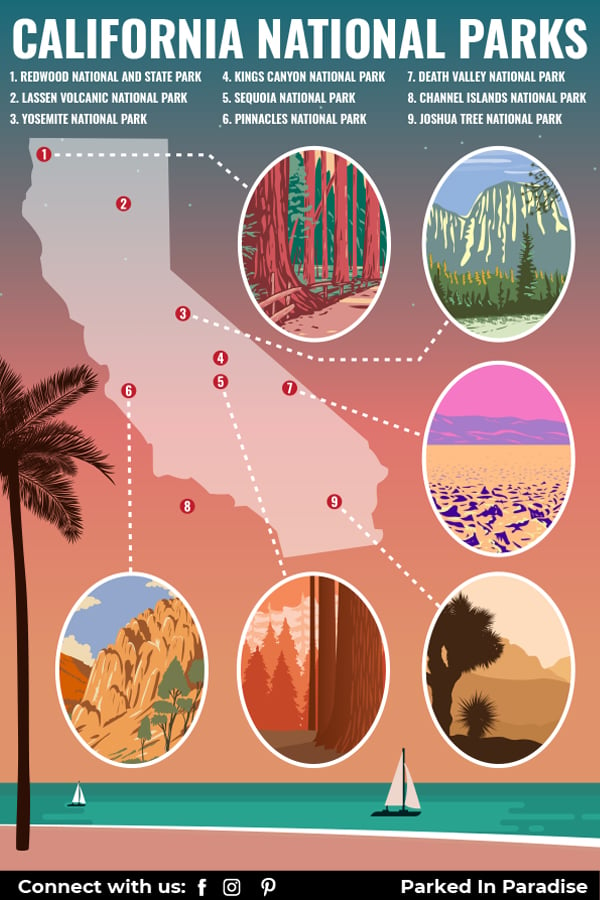
What National Parks Are In California?
There are 9 National Parks in California:
- Channel Islands National Park
- Death Valley National Park
- Joshua Tree National Park
- Kings Canyon National Park
- Pinnacles National Park
- Lassen Volcanic National Park
- Redwood National and State Park
- Sequoia National Park
- Yosemite National Park
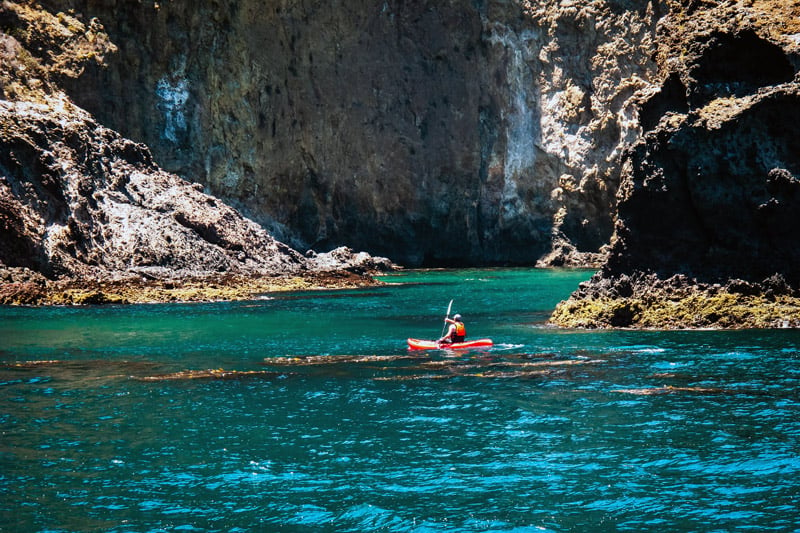
Channel Islands National Park
Channel Islands National Park provides multiple activities to do and scenic areas to explore among a group of five islands.
Travelers can go hiking, whale watching, boating, and more on the islands. All five of the islands also have service-managed campgrounds available for those who want to stay overnight.
While wandering over the islands’ terrain, tourists can keep an eye out for local wildlife on land and sea, including island foxes, bald eagles, California sea lions, dolphins, otters, and whales.
Natural habitats that are part of these islands include dunes, wetlands, lagoons, and intertidal areas.
Pets are not allowed on any part of Channel Islands National Park in order to protect local species from parasites and diseases. Service animals must meet strict health protocols before being allowed on any of the islands.
Getting There
Visitors can reach Santa Cruz and Anacapa Islands via ferry from Ventura Harbor in about an hour, or get to Santa Barbara, Santa Rosa, or San Miguel Islands in a few hours via ferry. Short flights to San Miguel and Santa Rosa Island from Camarillo Airport are available at certain times as well.
The park is open to the public all year round on a 24/7 basis, although visitor centers on the islands and mainland have limited hours.
Things to do in Channel Islands National Park:
- Hiking and camping
- Boating, kayaking, and canoeing
- Snorkeling and diving
- Fishing
- Surfing
- Tidepooling
- Bird watching
- Whale watching
- Seal and sea lion viewing
- Wildflower viewing
Things to do near Channel Islands National Park:
- McGrath State Beach and Campground (1 hour northeast)
- San Buenaventura State Beach (1 hour northeast)
- Emma Wood State Beach (1 hour northeast)
- Cachuma Lake Recreation Area (2 hours north)
- Los Padres National Forest (4 hours north)
Travel times include time for traveling via ferry from Santa Cruz or Anacapa Island to Ventura Harbor.
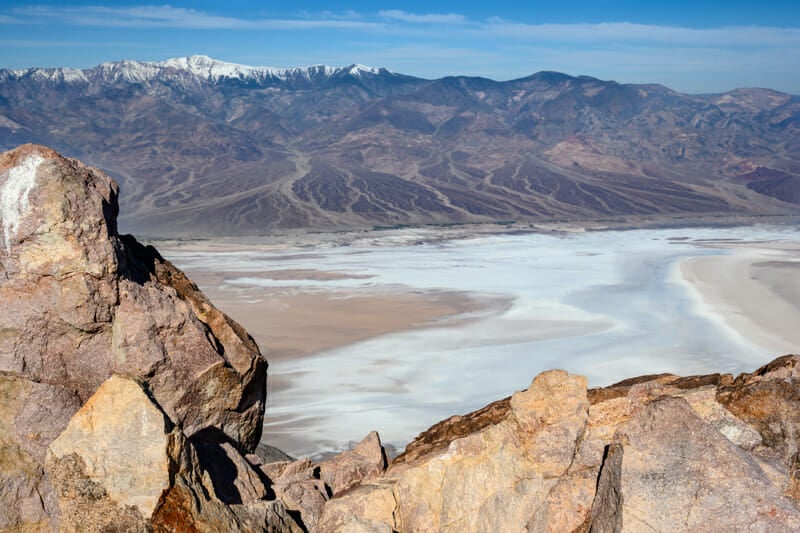
Death Valley National Park
Death Valley National Park offers hidden treasures, such as wildflower fields, that you might not expect in such a harsh environment.
This is the biggest National Park in California and has several areas to explore on foot or by car, as well as a main hub at Furnace Creek with restaurants, a gas station, campgrounds, and other amenities.
Explorers can see the salt flats at Badwater Basin, the Mesquite Flat Dunes near Stovepipe Wells, and geological formations at Copper Canyon and Furnace Creek. Many wildlife species call Death Valley home, including foxes, mountain lions, badgers, desert bighorn sheep, and burros.
Getting There
Visitors can reach the park, known for its hot and dry yet scenic environment, from a few main roads. CA Highway 190 from east to west, U.S. Route 95 from Nevada, and State Route 178 from the west all lead into the park.
Tourists should make note that cellphone reception is unreliable throughout Death Valley, and caution should be used when driving along the roads due to their age and condition.
Camping
Death Valley has 9 established campgrounds that are perfect for both tent and RV campers. Four of the campgrounds are free of charge which is great for someone traveling on a budget.
Those who are looking for an extended adventure can go backcountry camping in many areas of the park, as long as they bring plenty of water and take other safety precautions.
Pets are allowed in most developed areas of Death Valley, although they must be leashed at all times. Although they are not allowed on the park’s trails, there are many secluded dirt roads throughout the park that can give you the impression of hiking. And pets are permitted on all roads.
Things to do in Death Valley National Park:
- Hiking and camping
- Backpacking
- Driving backcountry roads
- Road and mountain biking
- Trailrunning
- Night sky viewing
Things to do near Death Valley National Park:
- Rhyolite Ghost Town (10 minutes northeast)
- Ash Meadows National Wildlife Refuge (30 minutes east)
- Amargosa River Natural Area (1 hour south)
- Dumont Dunes Off-Highway Vehicle Area (1 to 1.5 hours southeast)
- Manzanar National Historic Site (1 hour west)
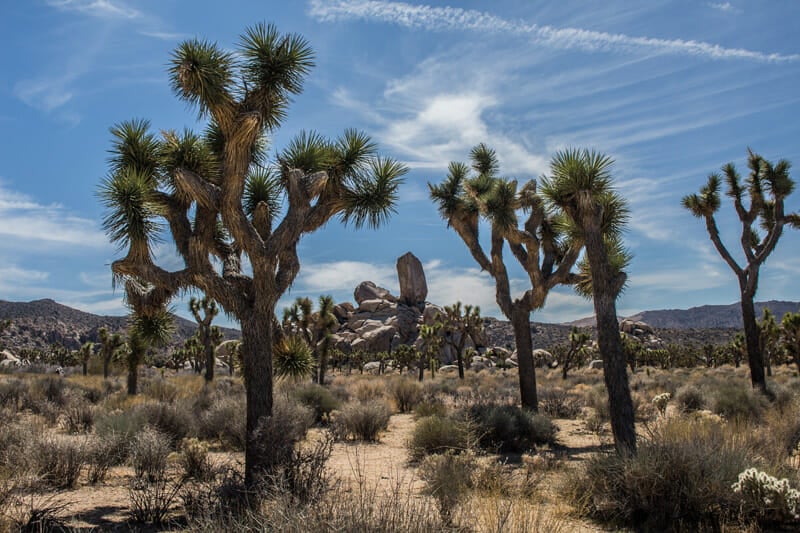
Joshua Tree National Park
Joshua Tree National Park in southern California consists of two desert ecosystems for visitors to enjoy, along with several recreational activities.
The park is filled with distinctive Joshua trees, as well as cultural rock art, prehistoric sites, and fan palm oases for shade. Local wildlife that roam through the park include coyotes, foxes, black bears, mountain lions, badgers, mule deer, bald eagles, hawks, and tortoises.
Thousands of established rock climbing routes make Joshua Tree a premier location for climbers looking to advance their skills. Year-round mild weather also makes it the perfect place to practice during the off-season.
Those who visit the park can also enjoy the 18-mile Geology Road Tour by car, which offers impressive views all around. Horseback riding, hiking, and photography are other popular activities. Joshua Tree has impressively dark skies so you can get a front-row view to millions of stars at night.
Getting There
Those who plan to visit the park can reach it by taking CA Highway 62 or I-10. Joshua Tree National Park is open all year, although certain seasons are busier than others, such as the spring and fall when temperatures are most manageable.
Camping
Visitors can stay at one of nine campgrounds in Joshua Tree if they plan on being at the park for more than a day. There are also an abundance of dispersed camping sites in the surrounding area.
Pets are allowed in certain areas within the park, including within 100 feet of campgrounds, picnic areas, and roads. All pets have to be on a leash while in the park. Pets are not allowed inside park buildings, on hiking trails, or in backcountry areas.
Things to do in Joshua Tree National Park:
- Camping, hiking, and backpacking
- Rock climbing
- High-lining and slack-lining
- Birding
- Photography
- Stargazing
- Horseback riding
- Wildflower viewing
Things to do near Joshua Tree National Park:
- Sheephole Valley Wilderness (30 minutes east)
- Coachella Valley National Wildlife Refuge (45 minutes west)
- Cleghorne Lakes Wilderness Area (2 hours northeast)
- San Bernardino National Forest (1 to 1.5 hours west)
- Mount San Jacinto State Park (1.5 hours west)
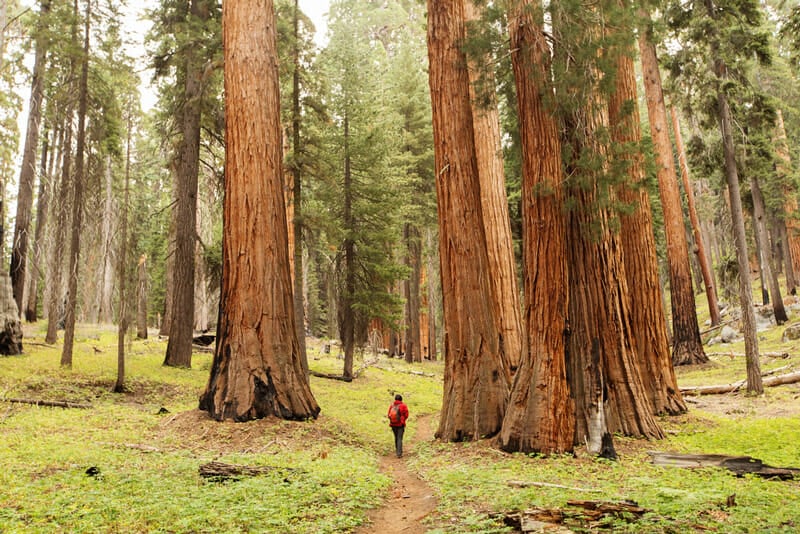
Kings Canyon National Park
Kings Canyon National Park gives visitors a chance to see the deepest canyon and one of the biggest sequoia tree groves in the U.S.
Visitors can get to the park, which is open 24 hours a day throughout the year, via Highway 180 from Fresno.
Those who visit the park have two main areas to explore, including Cedar Grove and Grant Grove. Tourists can hike along trails in scenic Zumwalt Meadow in Cedar Grove, or see the famous General Grant Tree and stock up on supplies at Grant Grove Village.
The park provides opportunities to take scenic drives throughout the area. Kings Canyon Scenic Byway offers incredible views of Kings Canyon and has numerous places to stop for photos or some hiking.
Generals Highway offers a convenient way to get from Kings Canyon to neighboring Sequoia National Park. For those who want to learn more about the area while exploring, guided tours are available. Visitors can also plan hikes or drives to get views of Roaring River Falls and Grizzly Falls.
Camping
There are fourteen campgrounds in King’s Canyon and Sequoia. You’ll find a mix of amenities for tent and RV campers ranging from more primitive sites to those with showers and dump stations.
A free shuttle bus that runs throughout the park makes it easy to set up camp and explore the area without the use of a vehicle.
Pets are not allowed in many parts of the park, including paved trails, for safety reasons. Pets on leashes are allowed in picnic areas, parking lots, campgrounds, and paved roads.
Things to do in Kings Canyon National Park:
- Day hiking or backpacking
- Camping
- Drive the Generals Highway and Kings Canyon Scenic Byway
- Picnicking
- Rock climbing
- Wildlife watching
- Horseback riding
- Winter skiing and snowshoeing
- Snowplay areas for kids
Things to do near Kings Canyon National Park:
- Gamlin Cabin (5 minutes west)
- Sierra National Forest (1.5 hours northwest)
- Big Sandy Creek Footbridge (1.5 hours west)
- Ferda Falls (2.5 hours northwest)
- Inyo National Forest (4.5 hours north)
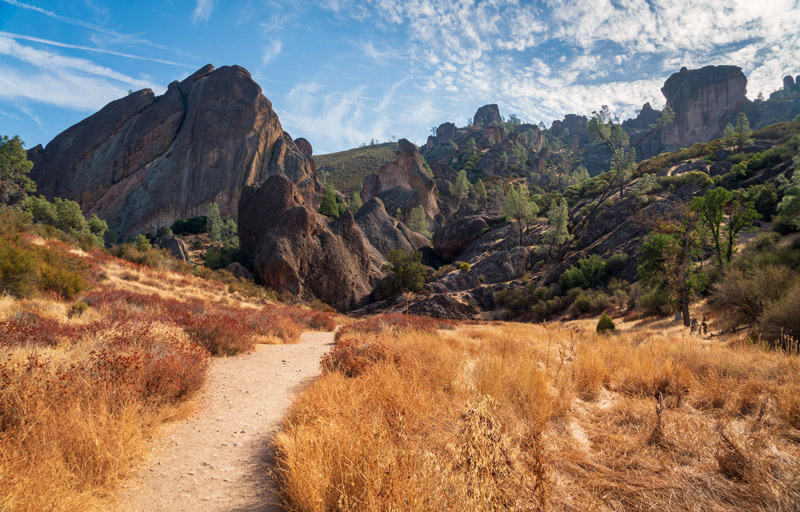
Pinnacles National Park
Pinnacles National Park provides exciting activities and impressive natural surroundings, including rare talus caves and visually striking rock formations.
Visitors can reach the park, which is located between San Francisco and Los Angeles, from the north or south by taking Highway 146 to one of the entrances.
Pinnacles National Park features Bear Gulch Cave, home to one of the largest colonies of big-eared bats in the area. The cave is open part of the year at certain times depending on bat activity.
While exploring the park, tourists can watch for other local wildlife species, including gray foxes, mule deer, peregrine falcons, and California condors.
Several trails are available throughout Pinnacles, including loops that offer views of Machete Ridge and other rock formations, wildflowers, and more.
Adventurers who want a challenge can go climbing on volcanic breccia rock in certain areas of the park. Pinnacles is a well-known climbing destination for those who want to test their skills.
Camping
Pinnacles Campground is located on the eastern side of the park and has 134 sites for those who wish to stay overnight. The campground has electric hookups, showers, and a dump station for RV campers.
Pets are permitted in some areas of Pinnacles National Park, such as campgrounds, paved roadways, picnic areas, and parking lots. Visitors should keep in mind that all pets are required to be on a leash. Pets aren’t allowed inside buildings or on any park trails.
Things to do in Pinnacles National Park:
- Hiking
- Camping
- Rock climbing
- Bird watching
- Talus caves
- Ranger programs
Things to do near Pinnacles National Park:
- Hollister Hills State Vehicular Recreation Area (45 minutes northwest)
- Pacheco State Park (1 hour north)
- Henry W. Coe State Park (1 to 1.5 hours north)
- Pfeiffer Big Sur State Park and Campground (2 hours west)
- Los Padres National Forest (5 hours south)
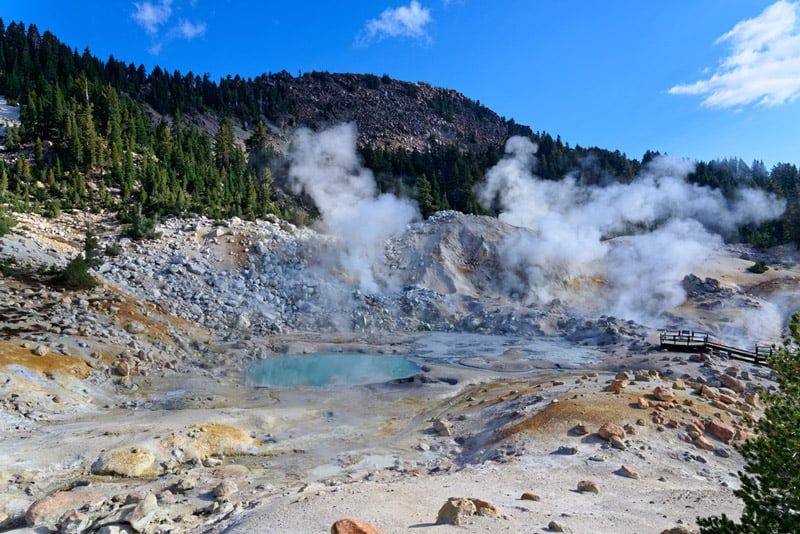
Lassen Volcanic National Park
Lassen Volcanic National Park, located in northern California, offers 150 miles of trails for visitors to explore.
Those heading to the park can reach it by taking Highway 36 from the south or Highway 44 from the north.
The park, which has four different types of volcanoes, is open to the public 24 hours a day all year round. During winter, some areas are harder to reach due to snowy conditions.
Hikers can see volcanic peaks, hydrothermal areas, and lakes, which are all part of the Lassen Volcanic Wilderness. Several animals can be found throughout the park, including snowshoe hares, American pikas, peregrine falcons, bald eagles, and sagebrush lizards.
Those who want to enjoy the water can go boating in one of the park’s alpine lakes, including Juniper Lake, Butte Lake, and Manzanita Lake. Fishing is also available.
In the winter, travelers can spend their time skiing and snowshoeing. Snow camping is also offered at the Southwest Walk-in Campground.
Camping
There are eight campgrounds in Lassen for RV and tent campers. The campgrounds offer flush toilets, however only one has showers and laundry services.
Pets
Those who have pets should note that the park allows pets in all areas that cars can go, including roads, picnic areas, campgrounds, and parking lots. Pets must be on leashes anytime they are outside of a vehicle. Pets are not allowed in the backcountry, on hiking trails, inside buildings and park facilities, and in water.
Things to do in Lassen Volcanic National Park:
- Auto tours
- Camping
- Stargazing
- Day hiking or backpacking
- Biking
- Boating
- Fishing
- Snowshoeing, skiing, and snowboarding
- Snowplay areas for kids
- Guided horseback rides
Things to do near Lassen Volcanic National Park:
- Latour State Forest (1 hour northwest)
- Ash Creek State Wildlife Area (1.5 hours northeast)
- Modoc National Forest (2 hours north)
- Shasta-Trinity National Forest (2 hours northwest)
- Plumas National Forest (2.5 hours southeast)
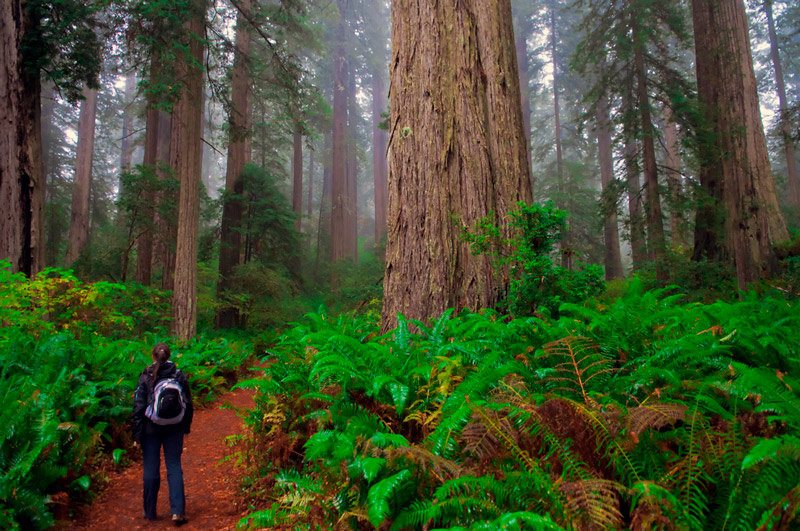
Redwood National and State Park
Redwood National and State Parks provide a way to see the tallest trees on the planet, as well as many other natural features.
Visitors can reach the parks via Highway 101 from the coast or I-5 from central California or central Oregon. The parks are open throughout the year overall, although campgrounds and visitor centers have seasonal hours of operation.
The Redwoods offer plenty to do for those who want to spend the day or stay overnight. Visitors can explore the parks’ tidepools at False Klamath Cove, Endert’s Beach, or Damnation Creek.
Horseback riding, kayaking, and biking are also available. Those who want to enjoy the parks for a couple of days or more can head to one of the campgrounds or venture into the backcountry to set up camp.
For those just passing through, scenic drives are available, including Coastal Drive, Howland Hill Road, and Bald Hills Road, which all provide stunning views of redwoods and other natural surroundings.
Pets are not allowed on any of the trails or in any buildings within Redwood National and State Parks. Service animals are allowed in these areas, although visitors should keep a close eye out for mountain lions, bears, and other large animals that are around.
Pets can be brought to developed campgrounds, parking areas, scenic view points, and beaches throughout the parks. Pets are also allowed on gravel roads. All pets must remain on leashes in the parks.
Things to do in Redwood National and State Park:
- Scenic drives
- Hiking and camping
- Biking
- Tidepooling
- Wildlife viewing
- Kayaking
- Horseback riding
- Ranger programs
Things to do near Redwood National and State Park:
- Humboldt Bay National Wildlife Refuge (1.5 to 2 hours south)
- Six Rivers National Forest (2 hours east)
- Marble Mountain Wilderness Area (2.5 hours east)
- Klamath National Forest (3 to 3.5 hours northeast)
- King Range National Conservation Area (3.5 hours south)
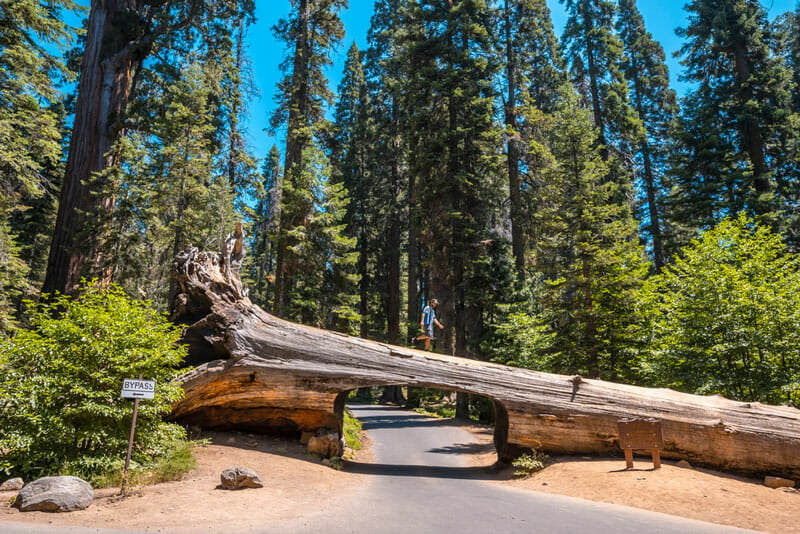
Sequoia National Park
Sequoia National Park, located next to Kings Canyon National Park, offers sequoia groves, places to do rock climbing, and a cave to explore.
The park is open 365 days a year for 24 hours a day although some of the roads within the park are closed during winter.
Visitors can get to the park’s main entrance by taking Highway 198 to the entrance at Three Rivers. Those who want to head to the more remote area of the park at Mineral King can drive along an unpaved road to get there.
While driving or hiking through the park, tourists can look for local wildlife, which include bighorn sheep, black bears, foxes, golden eagles, hawks, and turtles. The park also features guided tours of Crystal Cave, a marble cavern, although these are only offered on a seasonal basis.
Camping
14 campgrounds in Sequoia and King’s Canyon offer a retreat for campers who plan on being in the park for more than a day. There are over 1,000 campsites for tent and RV campers that are located right next to some of the most popular trails.
A free shuttle service is also available throughout the park so you can set up camp and explore without getting back in your vehicle.
Pets are allowed in some areas of Sequoia National Park, including campgrounds, parking lots, picnic areas, and paved roads. Pets must be on a leash at all times in these areas.
Pets are not allowed on any of Sequoia National Park’s trails or inside buildings. Service animals are allowed to go in any areas of the park with their companion.
Things to do in Sequoia National Park:
- Day hiking and backpacking
- Visiting the sequoia groves
- Picnicking
- Scenic drives
- Rock climbing
- Wildlife viewing
- Crystal Cave
- Snowplay areas for kids
- Skiing
- Snowshoeing
- Horseback riding
Things to do near Sequoia National Park:
- Pixley National Wildlife Refuge (1.5 hours southwest)
- Mountain Home State Forest (2 hours southwest)
- Sierra National Forest (2 hours north)
- Bright Star Wilderness (3 hours south)
- Red Rock Canyon State Park (3 hours south)
- Inyo National Forest (5 hours north)
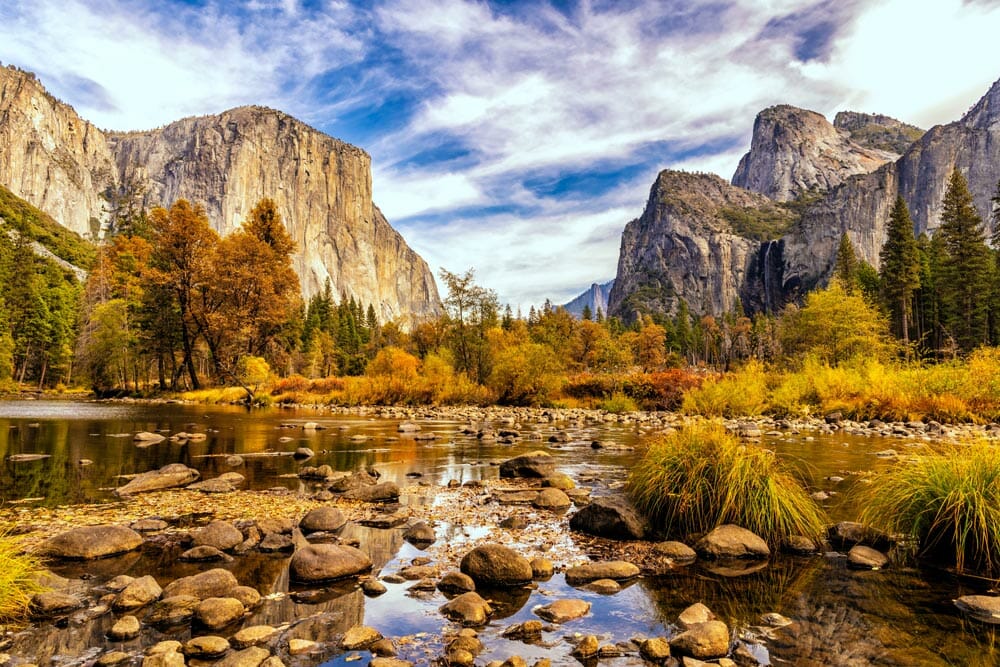
Yosemite National Park
Yosemite National Park in eastern California offers picturesque views of waterfalls, giant sequoias, valleys, meadows, and more. The park is open throughout the year, but certain areas cannot be reached in winter when it’s snowy.
Visitors can reach Yosemite National Park from the north or west via Highway 120 at Manteca or Highway 140 at Merced. Those coming to the park from the south can take Highway 41.
Yosemite National Park is home to many animals, including Sierra Nevada bighorn sheep, red foxes, mule deer, spotted owls, and black bears.
Visitors hiking along the park’s trails can watch for these species and other local wildlife. The park has many scenic roads, including Tioga Road, for those who want to explore the area by car.
Several water activities are also available in the park’s rivers, such as kayaking, canoeing, and whitewater rafting. Ranger programs are offered as well for those who want to learn more Yosemite National Park and its natural features.
Other activities include horseback riding, rock climbing, and skiing and snowshoeing during winter. Each season offers a dramatically different experience.
Hiking
Yosemite has a mix of over 50 hiking trails that are perfect for both beginners and experienced hikers. 16 day hiking trails in Yosemite Valley offer an unforgettable adventure for those wishing to get some of the most dramatic views of the park.
Hiking the Half Dome trail is the most popular in the park. It includes over 4,800 feet of elevation gain and requires the use of cables to reach the top.
Camping
13 campgrounds in Yosemite are available for tent and RV campers. Although none of the campgrounds have electricity or showers, there are dump stations and flush toilets.
Pets are allowed in some parts of Yosemite National Park, including developed areas, most campgrounds, and fully paved roads, bike paths, and sidewalks. Pets should be on leashes at all times in these areas. Pets are not allowed in walk-in campgrounds, group campsites, wilderness areas, trails, lodging areas, or public buildings.
Things to do in Yosemite National Park:
- Camping and backpacking
- Hiking
- Guided tours
- Photography
- Fishing, swimming and boating
- Birdwatching
- Biking
- Auto tours
- Horseback riding
- Rock climbing
- Stargazing
- Skiing and snowshoeing
Things to do near Yosemite National Park:
- Sierra National Forest (5 minutes southeast)
- Red Hills Recreational Management Area (1 hour west)
- Lake McSwain Recreational Area (1.5 hours southwest)
- Stanislaus National Forest (2 hours northwest)
- Eldorado National Forest (3 to 3.5 hours northwest)
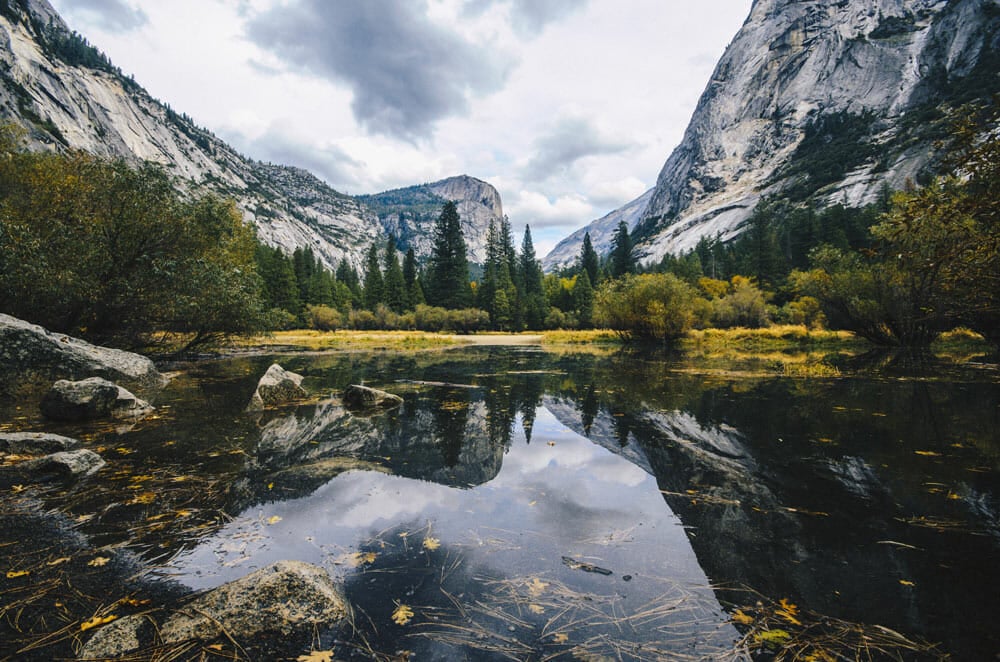
National Monuments & Historic Sites In California
These National Monuments, Historic Sites, and National Recreation Areas are also maintained by the National Park Service in California.
- Alcatraz Island
- Cabrillo National Monument
- Castle Mountains National Monument
- Cesar E. Chavez National Monument
- Devil’s Postpile National Monument
- Eugene O’Neill National Historic Site
- Fort Point National Historic Site
- Golden Gate National Recreation Area
- John Muir National Historic Site
- Lava Beds National Monument
- Manzanar National Historic Site
- Mojave National Preserve
- Muir Woods National Monument
- Point Reyes National Seashore
- Port Chicago Naval Magazine National Memorial
- Presidio of San Francisco
- Rosie The Riveter WWII Home Front National Historic Park
- San Fransisco Maritime National Historic Park
- Santa Monica Mountains National Recreation Area
- Tule Lake National Monument
- Whiskeytown National Recreation Area
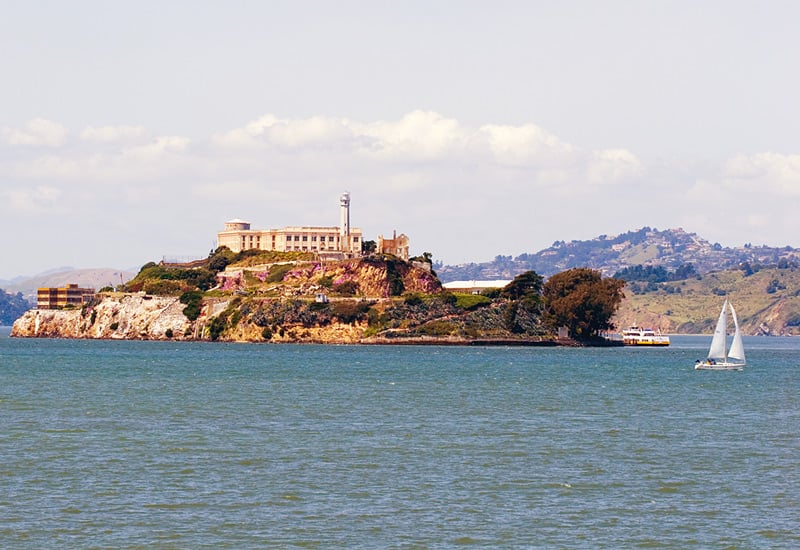
Alcatraz Island
Alcatraz Island offers a chance to explore a place that was once a federal penitentiary, military prison, and fort at various times.
Behind the scenes tours provide visitors with additional information on the history of Alcatraz, while combined with nearby Angel Island are also available. The hours of operation for Alcatraz Island vary by season.
Visitors can reach the island by ferry cruises departing from Pier 33 in San Francisco. While on the island, visitors can watch for the area’s waterbirds, including snowy egrets, cormorants, and herons.
Things to do in Alcatraz Island:
- Guided tours
- Birdwatching
Things to do near Alcatraz Island:
- Downtown San Francisco (10 to 15 minutes south)
- Golden Gate National Recreation Area (15 minutes north)
- McLaughlin Eastshore State Seashore (20 minutes east)
- Point Pinole Regional Shoreline (30 to 45 minutes north)
- Angel Island State Park (1 hour north)
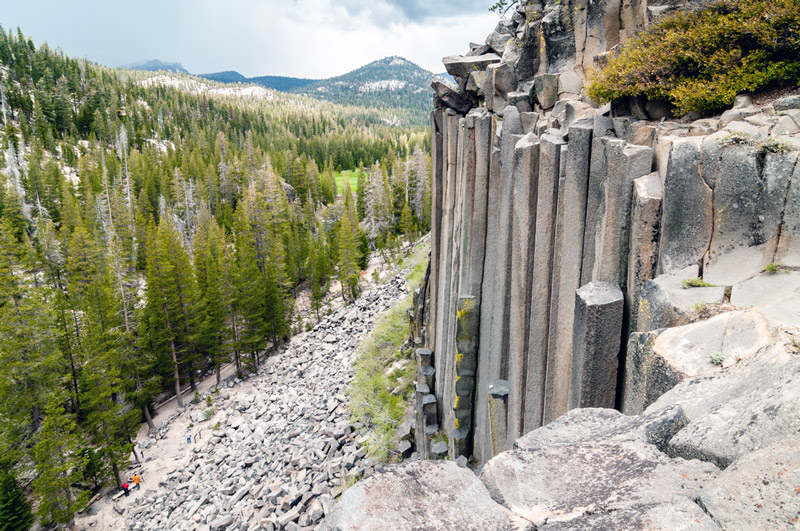
Devil’s Postpile National Monument
Devil’s Postpile National Monument features an unusual rock formation, scenic mountain views, and waterfalls.
Visitors can get to this eastern California park via U.S. Highway 395 and State Road 203 toward Minaret Vista. The monument is open on a seasonal basis depending on weather conditions.
Devil’s Postpile National Monument is known for its long rock columns formed by lava flowing and cooling. Tourists can hike around the area and do other activities nearby, including fishing and mountain biking.
Things to do in Devil’s Postpile National Monument:
- Hiking
- Guided tours
- Fishing
- Wildlife watching
- Horseback riding
- Mountain biking and cycling
- Skiing
- Snowshoeing
Things to do near Devil’s Postpile National Monument:
- Minaret Falls Campground (5 minutes north)
- Crystal Lake Trailhead (45 minutes east)
- Mammoth Mountain (45 minutes east)
- June Mountain Ski Area (1 hour north)
- Mono Lake (1 hour north)
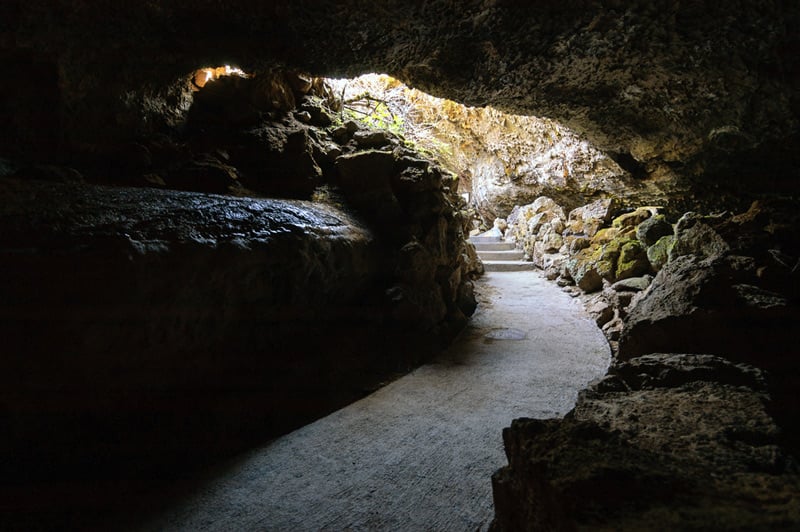
Lava Beds National Monument
Lava Beds National Monument, located close to the Oregon border in northern California, has several volcanic features, as well as Native American rock art, caves, and more.
Visitors can get to the park a few different ways, including Highway 139, Highway 161, and Highway 89. The park, including trails and caves, is open all year round, although snowy weather sometimes closes park roads.
Guided tours of the area, which includes historic battlefields, desert wilderness, and other features, are available.
Things to do in Lava Beds National Monument:
- Hiking
- Caving
- Wildlife viewing
- Guided tours
Things to do near Lava Beds National Monument:
- Tule Lake National Wildlife Refuge (20 minutes north)
- Modoc National Forest (45 minutes southeast)
- Shasta-Trinity National Forest (2-2.5 hours southwest)
- Klamath National Forest (2.5 hours west)
- Latour State Forest (2.5-3 hours south)
California National Historic Trails
- California National Historic Trail
- Juan Bautista de Anza National Historic Trail
- Old Spanish National Historic Trail
- Pony Express National Historic Trail

This Post Has 0 Comments